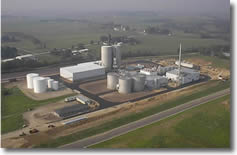Drinking Water Protection
- Drinking Water Protection Home
- About Us
- A-Z Index of Contaminants in Water
- Community Public Water Supply
- Drinking Water Grants and Loans
- Drinking Water Institute
- Drinking Water in Schools and Child Cares
- Drinking Water Revolving Fund
- Laws and Rules
- Noncommunity Public Water Supply
- Source Water Protection
- Water Operator and Certification Training
- Drinking Water Protection Contacts
Related Topics
- Annual Reports
- Drinking Water Risk Communication Toolkit
- Drinking Water Protection External Resources
- Fact Sheets
- Forms
- Invisible Heroes Videos: Minnesota's Drinking Water Providers
- Noncom Notes Newsletter
- Sample Collection Procedures (videos, pictures, written instructions)
- Waterline Newsletter
Related Sites
- 10 States Standards
- Clean Water Fund
- Health Risk Assessment – Guidance Values and Standards for Water
- Minnesota Well Index
- Water and Health
- Wells and Borings
Environmental Health Division
Ethanol Production Dependent on Water
From the Summer 2006 Waterline
Quarterly Newsletter of the Minnesota Department of Health Public Water Supply Unit, Waterline
A complete list of feature stories can be found on the Waterline webpage.
“People don’t realize how important water is in the manufacture of ethanol,” says John Lapointe, a design engineer for U. S. Water Services of Plymouth, Minnesota. Ethanol as a fuel additive is growing in prominence, particularly in Minnesota, which is a prolific producer of corn, the raw material needed for ethanol.
In Minnesota, the southwestern part of the state has an abundance of corn, but it is also the region where the water quantity and quality challenges are the greatest. “That usually means significantly more capital costs, installing equipment to treat the water,” said Randy Meyer, one of the co-founders of U. S. Water Services, which supplies water treatment systems for industrial use and assists with the design.
“It’s amazing how much water is needed for the ethanol process,” Lapointe adds. “The second part of it is it’s amazing how the treatment of it is so critical. The water has to be brought up to ultrapure standards for the cooling tower, for the boiler, and all these things. And it’s hard to discharge. So it’s finding a good source—finding volume—and it has to be high quality or it has to be treated at a high level, and then it’s being able to discharge it.”
Meyer cited other factors to be considered in selecting a site for an ethanol plant, such as rail lines, infrastructure, power, labor, and raw materials. “Water is just one of the factors, but without it, you can’t run the plant,” said Meyer, noting also that the plant also couldn’t be operated without a way to discharge the water. Depending on what minerals and other constituents are in the raw water, a facility may have to treat the water before discharging it into the environment following its operations. “The quality of the raw water is the biggest factor as to whether they’ll be able to discharge into the environment and how the design of the water treatment plant occurs with the plant.” Regulations regarding discharge vary from state to state. In Minnesota, the amount of total
dissolved solids in the discharge water is a significant issue.
For an ethanol plant, the water first goes through a pre-treatment phase, which can consist of reverse osmosis, iron filters, and/or lime softening, before splitting into two streams. Some of the water goes to the process, or contact, side. This water is recycled during the process and none leaves in liquid form, only through evaporation.
The rest is utility, or noncontact, water, which requires a higher degree of treatment for the boiler system and cooling tower. Reverse osmosis is used to remove approximately 98 percent of the minerals, which enhances the cycling process in the boiler and cooling system.
Cycling up refers to the inverse of the fraction of the solution containing the solids that are left behind when the water is boiled and evaporated. For example, if ¾ of the water is boiled off, ¼ of the solution is left. This is four cycles of concentration. The cycling also occurs in the cooling tower. Meyer said they run the plants at approximately 75 cycles of concentration. “If we can cycle up the water, we use less energy, fewer chemicals, less water, and have less environmental impact. It’s just more efficient for the plant.”
 |
 |
|
An ethanol plant. Photo courtesy of Badger State Ethanol.
|
John Lapointe and Randy Meyer of U. S. Water Services.
|
As for the southwestern part of Minnesota, some smaller ethanol plants have been operating, and U. S. Water Services is involved in several new ones that are now under construction. Meyer notes that the area contains many of the factors necessary for such a plant, including raw materials, transportation, and fuel sources and adds, “These plants require new and innovative ideas on how to handle the water and what waters can be used to allow them to operate economically in this area.”
An article in the December 26, 2005 Star Tribune: Newspaper of the Twin Cities said that farm-related businesses, particularly ethanol plants, are closing in southwestern Minnesota because of the arid nature of the region. Tim Cowdery, a hydrologist with the U. S. Geological Survey, was quoted in the article as saying, “People can see they’re running out of water. They’d like to build more.